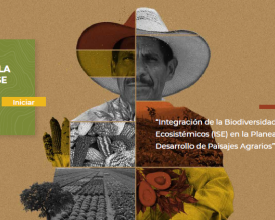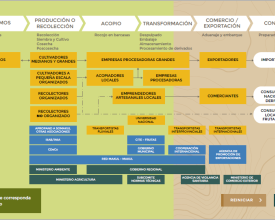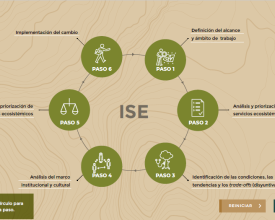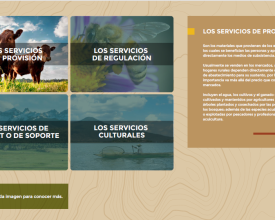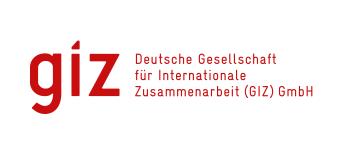
Building Capacity on Ecosystem Services and Sustainable Value Chains within the Mexican Ministry of Agriculture
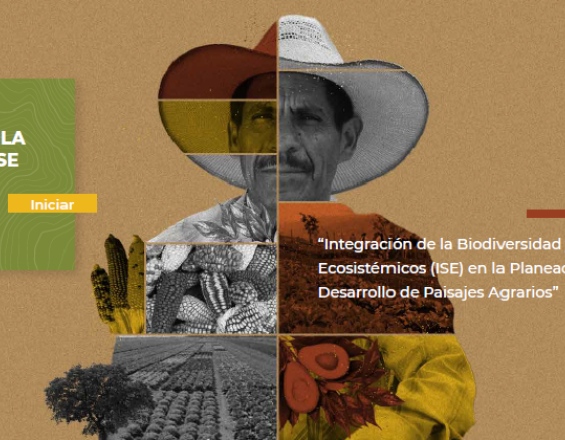
Agriculture depends heavily on biodiversity and ecosystem services; however, the agricultural sector often fails to take into account its value and the environmental costs of unsustainable practices in policies and decision making. For this reason, a strategy was designed to raise awareness of the value of biodiversity within the sector and its importance within the value chains in the rural sector among the staff of the Ministry of Agriculture. To this end, two virtual training courses were developed and installed, one for public servants on the integration of biodiversity and ecosystem services (ESI) in agriculture and the other for technicians on sustainable value chains. The aim is to integrate the value of biodiversity and ecosystem services into decision-making instruments and help producers implement sustainable and biodiversity-friendly production projects.
Context
Challenges addressed
The initial challenge began with the COVID 19 pandemic, which prevented the training from being given in person. On the other hand, the subject matter of the training is very avant-garde and breaks with old paradigms of agricultural management at the national level, focused on greater production through monocultures and overexploitation of the land. This represented a challenge in terms of approaching personnel within the Secretariat who were willing to promote new ideas, especially those related to the importance of working hand in hand with ecology, since agriculture depends on it. The real challenge is to ensure that the Secretariat's staff is able to translate the training into public policies and programs that take into account biodiversity, ecosystem services, sustainable value chains, climate change and the gender perspective.
Location
Process
Summary of the process
Agricultural management is a complex issue and requires capabilities with a comprehensive vision that takes into account environmental and socioeconomic factors. To this end, it is essential to enact laws and programs that integrate this vision in order to improve practices in the field. The training courses are innovative in terms of their comprehensive content and aim to raise awareness and sensitize decision-makers and technicians responsible for managing the country's agriculture. Thus, the digital format and its self-teaching methodology facilitated access to a large number of people. Similarly, the modular format and structure of the training courses allowed for different combinations so that the contents could be used in the future by different institutions.
However, the key factor was the willingness of the staff of the Secretariat of AGRICULTURE to collaborate in the revision and installation of the material on its internal platform. This work structure fostered a greater enthusiasm and sense of ownership of the trainings, which led them to promote them among their colleagues so that a greater number of people would take them and a good acceptance of them was created.
Building Blocks
Appropriation of training
The nesting of the trainings within the AGRICULTURE Secretariat was a strong factor, since they were completely appropriate as they were installed within its internal platform and available to all staff. In this way, they were not perceived as an external intervention, but rather as integrated and promoted within the Secretariat itself, giving them complete control over their management and evaluation. In addition, as an incentive, they were made equivalent to double the number of hours taken in order to make them more attractive to users and to reach as many people as possible.
Enabling factors
- Good and strong relationship with the Secretariat of AGRICULTURE, with staff willing and motivated to collaborate in the management of training.
- Digital infrastructure available to the Secretariat staff.
- Joint work between the digital content creation team and the Secretariat's communication team.
Lesson learned
With the nesting of training within the Secretariat's infrastructure, there is control over the management of materials and evaluations, which creates greater acceptance and motivation within the staff to conduct and promote training.
Comprehensive content development
In preparing the content, IICA sought to interrelate various topics within the management of agriculture in order to provide a more comprehensive vision. Topics such as climate change, gender, food self-sufficiency, integration of biodiversity, ecosystem services, inclusion of the rural sector and sustainable production practices, among others, were incorporated. This approach goes hand in hand with a holistic vision that encompasses various aspects that depend on or have a direct impact on agriculture. The Mexican agricultural sector is mostly rainfed, which means that it is highly dependent on rainfall cycles, making it more vulnerable to climate change. There are also many situations of exclusion for both gender and socioeconomic reasons. This is why it is important to integrate all these issues for a more complete analysis with greater impact on areas of opportunity.
Enabling factors
- There is a growing global trend towards the integration of these different issues within agriculture.
- There was a willingness and interest on the part of the Secretariat in this holistic vision.
Lesson learned
The agricultural sector has a great need to break with old paradigms and integrate more holistic visions for a more sustainable management of crops from production to trade.
Co-creation with Secretariat staff
The inclusion of secretariat personnel in the creation of the content, from the conception of the idea to the design phase, was a crucial factor in ensuring good acceptance of the training. Periodic and dynamic meetings were held to review the content and adapt the materials to the compliance standards and requirements that were requested. Likewise, progress was periodically reported to managers and finally, a pilot test was carried out with a certain number of users to gather their comments and possible adjustments.
Enabling factors
- There was a genuine interest on the part of several people within the secretariat who dedicated time and effort for the optimal implementation of the training.
- The people who cooperated had an impact in recommending and creating a positive opinion about the training within the Secretariat.
Lesson learned
- With the inclusion of the target audience in the review and management of the content, the acceptance and ownership of the materials is greater.
- There was an enthusiastic atmosphere and a feeling of contribution to the content and desire to cooperate was created.
Digitization of classroom training
The great advantage of these trainings was the transformation from face-to-face to digital format. A company specialized in communication and digital design was hired to adapt the materials. This entailed several challenges, but undoubtedly benefited in terms of the scope and massification of access to knowledge. A self-taught methodology was used where the student does not need any kind of support from a physical person, virtual characters were created to accompany him/her, animated videos and videos with real people, interactive, graphics and evaluations. This meant that only one single effort was needed to create the materials and that they could be available to all users of the platform without the need to rework the content.
Enabling factors
- The digital format entails a significant cost reduction when considering the scope of users compared to face-to-face training.
- The AGRICULTURE Secretariat already had an internal digital platform.
Lesson learned
Through digital trainings, it is possible to have a greater impact in a considerable way due to the ease of scalability and access for many people. Several institutions and universities even showed interest in being able to install them in their internal platforms, so the impact can continue to grow.
Impacts
- More than 800 public servants and more than 1,000 technicians were provided with two training courses on best practices in Mexican agriculture.
- The capacities of both public servants and technicians within the Ministry of Agriculture were strengthened with regard to biodiversity conservation issues in order to ensure their inclusion in public policies and field advisory services.
- Users were encouraged to design components, programs and actions focused on the integration of ecosystem services, sustainable value chains and biodiversity.
- The training provided users with tools to ground the concepts in their work contexts and enable their application in practice.
- Users were given the tools to recognize the importance of promoting inclusive and environmentally friendly sustainable production practices so that they can incorporate them into their decision making in their work projects.
- A total of 189 graphic materials were created, including infographics, videos, interactives and evaluations.
Beneficiaries
- Public servants within the Ministry of Agriculture.
- Technical personnel. They accompany small and medium-sized producers who receive federal subsidy programs.
- Students.

